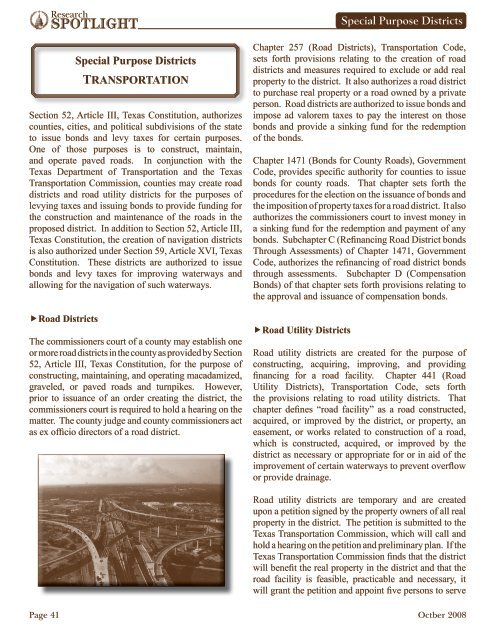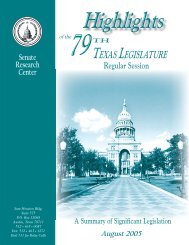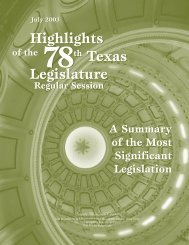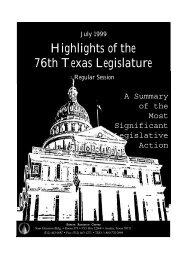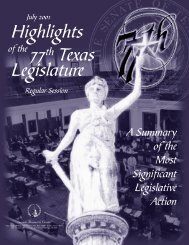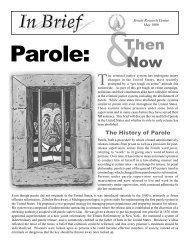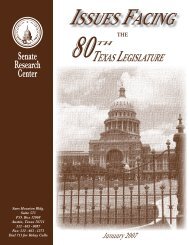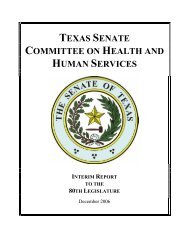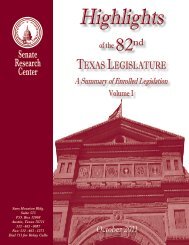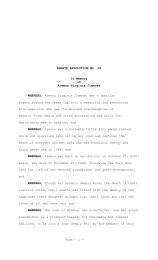Invisible Government: Special Purpose Districts in Texas - Senate
Invisible Government: Special Purpose Districts in Texas - Senate
Invisible Government: Special Purpose Districts in Texas - Senate
Create successful ePaper yourself
Turn your PDF publications into a flip-book with our unique Google optimized e-Paper software.
Research<br />
SPOTLIGHT<br />
<strong>Special</strong> <strong>Purpose</strong> <strong>Districts</strong><br />
TRANSPORTATION<br />
Section 52, Article III, <strong>Texas</strong> Constitution, authorizes<br />
counties, cities, and political subdivisions of the state<br />
to issue bonds and levy taxes for certa<strong>in</strong> purposes.<br />
One of those purposes is to construct, ma<strong>in</strong>ta<strong>in</strong>,<br />
and operate paved roads. In conjunction with the<br />
<strong>Texas</strong> Department of Transportation and the <strong>Texas</strong><br />
Transportation Commission, counties may create road<br />
districts and road utility districts for the purposes of<br />
levy<strong>in</strong>g taxes and issu<strong>in</strong>g bonds to provide fund<strong>in</strong>g for<br />
the construction and ma<strong>in</strong>tenance of the roads <strong>in</strong> the<br />
proposed district. In addition to Section 52, Article III,<br />
<strong>Texas</strong> Constitution, the creation of navigation districts<br />
is also authorized under Section 59, Article XVI, <strong>Texas</strong><br />
Constitution. These districts are authorized to issue<br />
bonds and levy taxes for improv<strong>in</strong>g waterways and<br />
allow<strong>in</strong>g for the navigation of such waterways.<br />
ffRoad <strong>Districts</strong><br />
The commissioners court of a county may establish one<br />
or more road districts <strong>in</strong> the county as provided by Section<br />
52, Article III, <strong>Texas</strong> Constitution, for the purpose of<br />
construct<strong>in</strong>g, ma<strong>in</strong>ta<strong>in</strong><strong>in</strong>g, and operat<strong>in</strong>g macadamized,<br />
graveled, or paved roads and turnpikes. However,<br />
prior to issuance of an order creat<strong>in</strong>g the district, the<br />
commissioners court is required to hold a hear<strong>in</strong>g on the<br />
matter. The county judge and county commissioners act<br />
as ex officio directors of a road district.<br />
<strong>Special</strong> <strong>Purpose</strong> <strong>Districts</strong><br />
Chapter 257 (Road <strong>Districts</strong>), Transportation Code,<br />
sets forth provisions relat<strong>in</strong>g to the creation of road<br />
districts and measures required to exclude or add real<br />
property to the district. It also authorizes a road district<br />
to purchase real property or a road owned by a private<br />
person. Road districts are authorized to issue bonds and<br />
impose ad valorem taxes to pay the <strong>in</strong>terest on those<br />
bonds and provide a s<strong>in</strong>k<strong>in</strong>g fund for the redemption<br />
of the bonds.<br />
Chapter 1471 (Bonds for County Roads), <strong>Government</strong><br />
Code, provides specific authority for counties to issue<br />
bonds for county roads. That chapter sets forth the<br />
procedures for the election on the issuance of bonds and<br />
the imposition of property taxes for a road district. It also<br />
authorizes the commissioners court to <strong>in</strong>vest money <strong>in</strong><br />
a s<strong>in</strong>k<strong>in</strong>g fund for the redemption and payment of any<br />
bonds. Subchapter C (Ref<strong>in</strong>anc<strong>in</strong>g Road District bonds<br />
Through Assessments) of Chapter 1471, <strong>Government</strong><br />
Code, authorizes the ref<strong>in</strong>anc<strong>in</strong>g of road district bonds<br />
through assessments. Subchapter D (Compensation<br />
Bonds) of that chapter sets forth provisions relat<strong>in</strong>g to<br />
the approval and issuance of compensation bonds.<br />
ffRoad Utility <strong>Districts</strong><br />
Road utility districts are created for the purpose of<br />
construct<strong>in</strong>g, acquir<strong>in</strong>g, improv<strong>in</strong>g, and provid<strong>in</strong>g<br />
f<strong>in</strong>anc<strong>in</strong>g for a road facility. Chapter 441 (Road<br />
Utility <strong>Districts</strong>), Transportation Code, sets forth<br />
the provisions relat<strong>in</strong>g to road utility districts. That<br />
chapter def<strong>in</strong>es “road facility” as a road constructed,<br />
acquired, or improved by the district, or property, an<br />
easement, or works related to construction of a road,<br />
which is constructed, acquired, or improved by the<br />
district as necessary or appropriate for or <strong>in</strong> aid of the<br />
improvement of certa<strong>in</strong> waterways to prevent overflow<br />
or provide dra<strong>in</strong>age.<br />
Road utility districts are temporary and are created<br />
upon a petition signed by the property owners of all real<br />
property <strong>in</strong> the district. The petition is submitted to the<br />
<strong>Texas</strong> Transportation Commission, which will call and<br />
hold a hear<strong>in</strong>g on the petition and prelim<strong>in</strong>ary plan. If the<br />
<strong>Texas</strong> Transportation Commission f<strong>in</strong>ds that the district<br />
will benefit the real property <strong>in</strong> the district and that the<br />
road facility is feasible, practicable and necessary, it<br />
will grant the petition and appo<strong>in</strong>t five persons to serve<br />
Page 41 Octber 2008


